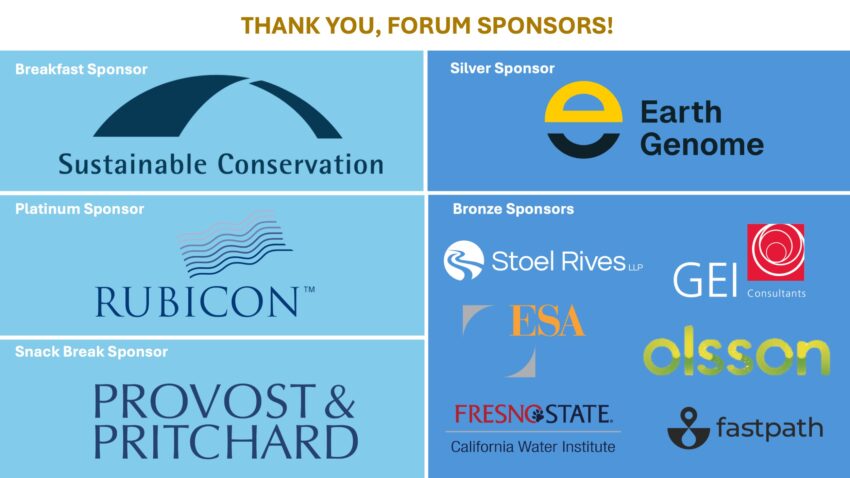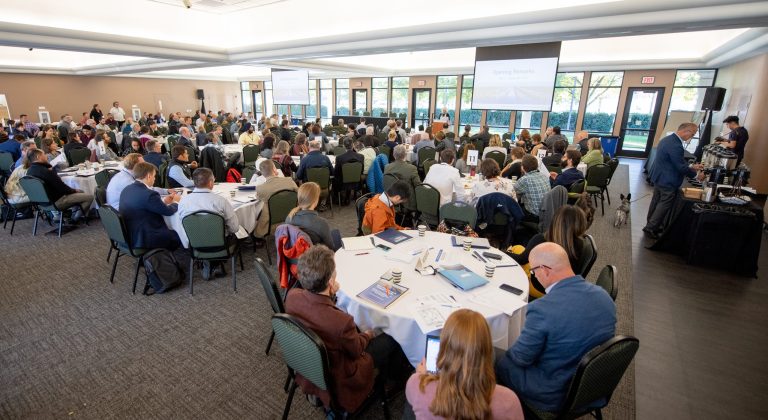Welcome to California’s Flood-MAR Hub
A one-stop shop for people seeking information and support in developing and implementing Flood-MAR projects.
A one-stop shop for people seeking information and support in developing and implementing Flood-MAR projects.
Kearney orchards recharge site studied by the UC Davis Dahlke Lab (Pasner, 2022).
🎉 The 2025 Flood-MAR Forum was a Success!!
Thank you to everyone who joined us November 5–6 for two incredible days of connection, learning, and momentum-building. The energy was off the charts! We couldn’t have done it without ALL OF YOU!!
Want to relive the highlights? Our friends at Sustainable Conservation put together a fantastic recap capturing the ideas, inspiration, and big takeaways. Check it out here: “From Concept to Practice: Reflections on the 2025 Flood-MAR Network Forum.”
And a HUGE THANKS to this year’s amazing sponsors who help keep the Network thriving and make this biannual event possible!


Developed by the Flood-MAR Network’s Estimating Recharge Action Team, this fact sheet offers practical, easy-to-use methods for estimating groundwater recharge from on-farm and flood-MAR projects. It outlines three primary approaches—the simple water budget method, flow measurement options, and direct measurement of ponded infiltration—along with real-world examples, reference links, and field guidance. Designed for landowners, Groundwater Sustainability Agencies, and practitioners, the document bridges scientific rigor and on-the-ground application to help improve recharge accounting and support sustainable groundwater management in California.
Get the Fact Sheet here!
Flood-MAR (Flood-Managed Aquifer Recharge) is a management strategy that uses high flood flows to spread water onto agricultural land, working landscapes, and managed natural areas to recharge aquifers, sustain riverine and groundwater-dependent ecosystems, and achieve other wide ranging benefits.
Conceptual Figure of Flood-MAR
Photo Credit: DWR
An aerial view looks toward a flooded agricultural field and a flock of birds in Butte County, California
Photo Credit: DWR
Flood-MAR strives to sustainably meet community- and environmentally-focused objectives while supplying multiple benefits to natural ecosystems, working landscapes, and California’s agriculture.
Flood-MAR is an important climate change adaptation strategy that can help California better prepare for and manage extreme events like floods and drought.
A drone view of floodwaters from the Sacramento River overtopping the Fremont Weir in Yolo County, California.
Photo Credit: DWR
Secretary Karen Ross, CA Department of Food and Agriculture, addresses the attendees at the 2019 Flood-MAR public forum held at California State University of Sacramento in Sacramento, California on October 28, 2019.
Photo Credit: Kelly M. Grow / DWR
Large-scale implementation of Flood-MAR depends on equitable partnerships across communities, public and private sectors at all levels.
Learn more about Flood-MAR in California Department of Water Resources’ White Paper and Research & Data Development Plan.
Flood-MAR White Paper
Photo Credit: DWR
Get involved in California’s Flood-MAR Network today!
Coachella Valley Water District’s Thomas E. Levy Groundwater Replenishment Facility (DWR, 2014).
The Flood-MAR Network is a collaboration among many individuals and organizations interested in promoting Flood-MAR implementation in California. This includes state, federal, tribal, regional, and local entities; nonprofits and community-based organizations; university and private researchers; private landowners; and other stakeholders.
History of the Network
In 2018, the need for greater use of Flood-MAR in California had arrived at a tipping point. The adoption of the Sustainable Groundwater Management Act was driving decision-making about how to achieve sustainable aquifer supplies. Moreover, climate change was driving an urgent need for increased flood protection and drought resilience for communities and ecosystems.
At this confluence of needs, many professionals with expertise related to Flood-MAR in California were brought together by California Department of Water Resources (DWR) to identify knowledge gaps and needs while also providing suggestions on how to promote more widespread implementation of Flood-MAR.
This group of people, known as the Flood-MAR Research Advisory Committee, contributed to the Research, Data and Development Plan (R&DD Plan) which outlined a wide range of recommendations in thirteen key categories considered essential for Flood-MAR implementation in California. These recommendations included changes in water governance, water management, groundwater data and analysis, water infrastructure, water rights, and water use practices.
In addition to the recommendations outlined in the RD&D Plan, the Research Advisory Committee acknowledged that achieving widespread Flood-MAR implementation will require interdisciplinary coordination and partnership. The Flood-MAR Network was identified as one effective way to encourage information sharing and collaboration while taking important steps toward implementation.

Attendees listen to opening remarks during the 2019 Flood-MAR Public Forum held at California State University of Sacramento (DWR, 2018).
Network Purpose Statement
The purpose of the Flood-MAR network is to improve water availability, flood risk reduction, and groundwater recharge to sustain communities and ecosystems through Flood-MAR implementation. Because Flood-MAR requires broad, equitable cooperation and coordination amongst multiple, diverse sectors of society and water resources management, this network is essential for creating necessary collaboration among Flood-MAR stakeholders. We want to leverage our collective expertise to share information, connect ideas, collaborate, and develop partnerships, so we can expand Flood-MAR knowledge and better support and expand project implementation.
Network Goals
Goal 1: Substantially increase groundwater storage, improve flood management, and enhance riparian and groundwater-dependent habitat in California through implementation of Flood-MAR.
Goal 2: Position the Flood-MAR Network as a credible resource when evaluating, planning, or implementing managed aquifer recharge projects.
Goal 3: Promote opportunities for connections and partnerships to leverage and build upon each other’s work.
Goal 4: Facilitate sharing of information that advances Flood-MAR implementation and promotes action.
Goal 5: Support each other as we pursue meaningful work separately and together.
Aerial view of the Sutter ByPass, a leveed channel of the Lower Sacramento Valley Flood-Control System along the southwest portion of the Sutter Basin (DWR).
A: Yes, check out the Projects page for examples of Flood-MAR projects throughout the state.
A: The objectives of Flood-MAR are wide-ranging and location-dependent. Potential benefits include the following:
A: It depends on several factors. Consider joining the Flood-MAR Network to collaborate with practitioners and researchers on your specific case.
A: Check out the Flood-MAR Network’s curated list of tools and data, guidance documents, and external references by looking at the Resources page.
Not finding what you need? Send us an email with your inquiry and we’ll see what we can do: floodmar.network@gmail.com
A: The Flood-MAR Network identified in the Research and Data Development Plan the following primary research topics that are key to wide-spread adaptation of Flood-MAR:
A: Sign up to join the Network on our Get Involved page! Flood-MAR Network members are invited to join our monthly Lunch-MAR Webinars, Biennial Flood-MAR Forum, technical workshops, networking opportunities, and more.
Copyright 2022-Present, Flood-MAR and Contributing Authors.
This website uses cookies so that we can provide you with the best user experience possible. Cookie information is stored in your browser and performs functions such as recognising you when you return to our website and helping our team to understand which sections of the website you find most interesting and useful.
Strictly Necessary Cookie should be enabled at all times so that we can save your preferences for cookie settings.
If you disable this cookie, we will not be able to save your preferences. This means that every time you visit this website you will need to enable or disable cookies again.